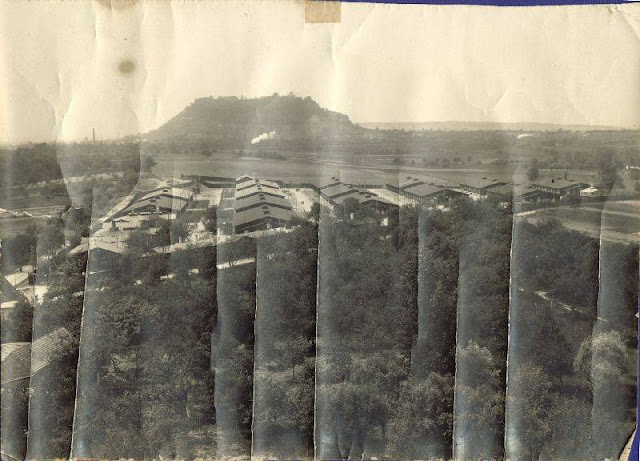Parmi les anecdotes curieuses que j’ai relevées dans les écrits de mon père, l’une reste assez évasive, c’est celle du mariage d’un prisonnier Français avec une femme Allemande. Les seuls indices que j’ai trouvés sont que les autorités Allemandes permettaient parfois ce genre d’union et que la femme devait alors vivre avec son mari au camp. Je pense que la plupart des relations entre hommes et femmes se faisaient dans les kommandos où la liberté était plus grande que dans le camp, il y a d’ailleurs cette anecdote dans un autre Stalag de cette dizaine de prisonniers qui travaillaient dans une usine et qui dormaient, toutes les nuits, dans leur baraque avec les ouvrières qu’ils avaient séduits. Mon père, sous-officier et « homme de confiance » eut donc la mission le 1er février 1942 lorsqu’il était à Bissingen, de marier un prisonnier Français avec une autochtone, en qualité extraordinaire d’officier de l’état civil. Il écrit d’ailleurs à ma mère dans une lettre cette drôle d’expérience : « Aujourd’hui, en ma qualité de sous-officier j’ai rempli les fonctions d’officier d’état civil pour le mariage d’un camarade d’un autre kommando du pays. Notre état de prisonniers crée des situations vraiment bizarres et je ne m’attendais guère à cette nouvelle fonction. ». Dans les kommandos qui travaillaient dans les fermes, la présence quasi continuelle du prisonnier avec la femme privée de son mari parti à la guerre, devait inciter de nombreux hommes à tenter l’aventure du fait d’un manque affectif flagrant, et peut-être de nombreuses femmes de même n’étaient pas insensibles à ces Français à la réputation sulfureuse de « coureurs de jupons ». L’illustration la plus connue se trouvant dans le film « La vache et le prisonnier ». Que ce soient de simples aventures ou de réelles histoires d’amour, il était bien naturel que ces situations se produisent, et cela alimentait nos gentilles impertinences lorsqu’adolescents nous taquinions notre mère, mon frère et moi, en lui disant : « Et si un jour la porte s’ouvrait et qu’un jeune homme apparaisse en disant (imitant un improbable accent Allemand): Bonchour, che zuis le fils de Georg ! Comment le prendrais-tu ? ». Et ma mère de répondre en souriant : « Je l’accueillerais avec plaisir. ». Et lorsque cette taquinerie se passait à table, devant mon père, celui-ci, comme à son habitude, restait imperturbable, souriant probablement intérieurement de notre tendre effronterie.
Among the curious anecdotes I have noted in my father's writings, one
remains rather evasive, that of the marriage of a French prisoner with a German
woman. The only evidence I found was that the German authorities sometimes
allowed this kind of union and that the woman then had to live with her husband
in the camp. I think that most of the relations between men and women took
place in the kommandos where freedom was greater than in the camp, and there is
this anecdote in another Stalag of these ten prisoners who worked in a factory
and slept, every night, in their barracks with the workers they had seduced. My
father, a non-commissioned officer and "trusted man", therefore had
the mission on February 1, 1942 when he was in Bissingen to marry a French
prisoner with a native woman, in an extraordinary capacity as a civil
registrar. In a letter to my mother, he wrote of this strange experience: "Today, as a non-commissioned officer,
I served as a civil registrar for the marriage of a comrade from another kommando
in the country. Our state of being prisoners creates really strange situations
and I hardly expected this new function. ». In the kommandos who worked on the
farms, the almost continuous presence of the prisoner with her husband's
private wife who had gone to war was to encourage many men to try the adventure
because of a blatant emotional lack, and perhaps many women of the same kind
were not insensitive to these Frenchmen with the sulphurous reputation of
"underskirt runners". The most famous illustration in the French film
“La vache et le prisonnier” ("The Cow and the Prisoner”). Whether they
were simple adventures or real love stories, it was only natural that these
situations would occur, and it fed our kind impertinence when we teased our
mother, my brother and I as teenagers, telling her: "What if one day the
door opened and a young man appeared saying (imitating an improbable German
accent): Hello, I’m Georg's son! How would you take it? ». And my mother replied with a smile: "I
would welcome her with pleasure. ». And when this teasing took place at the
table, in front of my father, he, as usual, remained imperturbable, probably
smiling inwardly at our tender cheek.




Aucun commentaire:
Enregistrer un commentaire
Si vous désirez la version numérique du livre Stalag VA merci de laisser votre adresse mail à: b.dusehu.becker@gmail.com
Als u de digitale versie van het boek Stalag VA wilt ontvangen, kunt u uw emailadres achterlaten op: b.dusehu.becker@gmail.com
If you would like the digital version of the book Stalag VA please leave your email address at: b.dusehu.becker@gmail.com